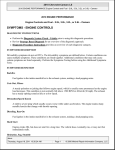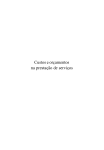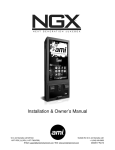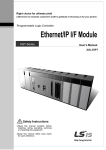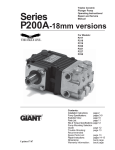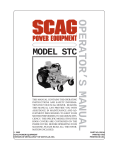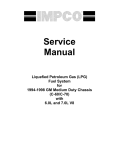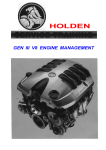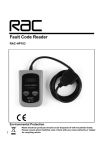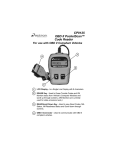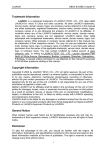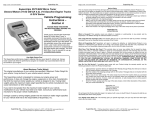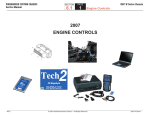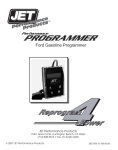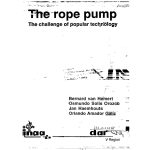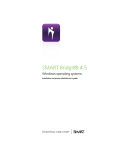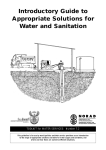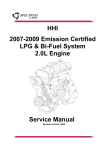Download 6.2l engine control and fuel troubleshoo... 166KB Oct 17 2012 12:28
Transcript
2010 Chevrolet Camaro LT 2010 ENGINE PERFORMANCE Engine Controls and Fuel - 4.8L, 5.3L, 6.0L, 6.2L, or 7.0L - Camaro 2010 ENGINE PERFORMANCE Engine Controls and Fuel - 4.8L, 5.3L, 6.0L, 6.2L, or 7.0L - Camaro SYMPTOMS - ENGINE CONTROLS DIAGNOSTIC INSTRUCTIONS Perform the Diagnostic System Check - Vehicle prior to using this diagnostic procedure. Review Strategy Based Diagnosis for an overview of the diagnostic approach. Diagnostic Procedure Instructions provide an overview of each diagnostic category. SYMPTOMS DESCRIPTION Symptoms cover conditions that are not covered DTCs. Certain conditions can cause multiple symptoms. These conditions are listed together under Symptoms Testing. Conditions that may only cause certain symptoms are listed separately under Additional Symptoms Test. Perform the Symptoms Testing before using the Additional Symptoms Tests. Poor Fuel Fill Quality test may be performed separately from the Symptoms Testing and Additional Symptoms Tests procedures. SYMPTOMS DEFINITION Backfire Fuel ignites in the intake manifold or in the exhaust system, making a loud popping noise. Cuts Out, Misses A steady pulsation or jerking that follows engine speed, which is usually more pronounced as the engine load increases. This condition is not normally felt above 1500 RPM or 48 km/h (30 mph). The exhaust has a steady spitting sound at idle or at low speed. Detonation/Spark Knock A mild to severe ping which usually occurs worse while under acceleration. The engine makes sharp metallic knocks that change with throttle opening. Dieseling, Run-On The engine continues to run after the key is turned OFF, but runs very rough. Hard Start Engine cranks OK, but does not start for a long time. The vehicle does eventually run, or may start but immediately stalls. steve Thursday, August 18, 2011 11:41:34 11:41:30 AM Page 1 © 2006 Mitchell Repair Information Company, LLC. 2010 Chevrolet Camaro LT 2010 ENGINE PERFORMANCE Engine Controls and Fuel - 4.8L, 5.3L, 6.0L, 6.2L, or 7.0L - Camaro Hesitation, Sag, Stumble Momentary lack of response as the accelerator is pushed down. This condition can occur at any vehicle speed. This condition is usually more pronounced when first trying to make the vehicle move, as from a stop. This condition may cause the engine to stall in severe conditions. Lack of Power, Sluggishness, or Sponginess The engine delivers less than expected power. Little or no increase in speed when the accelerator pedal is pushed down part way. Poor Fuel Economy Fuel economy, as measured by an actual road test, is noticeably lower than expected. Also, the fuel economy is noticeably lower than it was on this vehicle at one time, as previously shown by an actual road test. Poor Fuel Fill Quality Difficulty when refueling the vehicle. Rough, Unstable, or Incorrect Idle and Stalling The engine runs unevenly at idle. If severe, the engine or the vehicle may shake. Engine idle may vary in speed. Either condition may be severe enough to stall the engine. Surges/Chuggles Engine power variation under steady throttle or cruise. Feels like the vehicle speeds up and slows down with no change in the accelerator pedal position. SYMPTOMS VERIFICATION Before using the Symptom tables, perform the following inspections: Ensure that the engine control module and malfunction indicator lamp are operating correctly. Ensure that there are no DTCs that are stored. Ensure that the scan tool data is within a normal operating range. Verify the customer concern. Perform the Visual/Physical Inspection in this section. The visual/physical inspection is extremely important, and can lead to correcting a condition without additional testing. It may also help reveal the cause of an intermittent condition. Identifying Intermittent Conditions Many intermittent conditions occur with harness or connector movement due to engine torque, rough pavement, steve Thursday, August 18, 2011 11:41:31 AM Page 2 © 2006 Mitchell Repair Information Company, LLC. 2010 Chevrolet Camaro LT 2010 ENGINE PERFORMANCE Engine Controls and Fuel - 4.8L, 5.3L, 6.0L, 6.2L, or 7.0L - Camaro vibration or physical movements of a component. Refer to the following for a list of issues that may cause an intermittent condition: Moisture and water intrusion in connectors, terminals, and components Incomplete connector mating Poor terminal contact High circuit or component resistance-High resistance can include any resistance, regardless of the amount, which can interrupt the operation of the component. Harness that is too short or tight. Wire insulation that is chaffed or cut. High or low ambient temperature High or low engine coolant temperatures High underhood temperatures Heat build up in component or circuit due to circuit resistance, poor terminal contact, or high electrical load High or low system voltage High vehicle load conditions Rough road surfaces Electro-magnetic interference from relays, solenoids or other electrical surge Incorrect installation of aftermarket, add on accessories Visual/Physical Check Ensure that the control module grounds are clean, tight, and correctly located. Refer to Wiring Repairs . Ensure that the vacuum hoses are not split, kinked, and properly connected, as shown on the Vehicle Emission Control Information label. Ensure that the air filter is clean and free from restrictions. Ensure that there is no water intrusion in connectors terminals and components. Inspect the air intake ducts for the following conditions: Collapsed Damaged areas Looseness Incorrect installation Leaking Inspect for air leaks at the throttle body mounting area, the mass air flow sensor and intake manifold sealing surfaces. Inspect the wiring harness for the following conditions: Poor connections Pinches Cuts steve Thursday, August 18, 2011 11:41:31 AM Page 3 © 2006 Mitchell Repair Information Company, LLC. 2010 Chevrolet Camaro LT 2010 ENGINE PERFORMANCE Engine Controls and Fuel - 4.8L, 5.3L, 6.0L, 6.2L, or 7.0L - Camaro Inspect for loose, damaged, unseated, or missing sensors/components. Inspect the terminals for corrosion and correct contact. SYMPTOMS TESTING Backfire, Cuts Out/Misses, Detonation/Spark Knock, Dieseling/Run-On, Hard Start, Hesitation/Sag/Stumble, Lack of Power/Sluggishness/Sponginess, Poor Fuel Economy, Rough, Unstable, or Incorrect Idle and Stalling, or Surges/Chuggles 1. Test for the following conditions: The fuel system for the following: Correct fuel pressure-Refer to Fuel System Diagnosis. Fuel injectors that are leaking or improper operation-Refer to Fuel Injector Diagnosis (w/J39021 or w/Tech 2) or Fuel Injector Diagnosis (w/CH47976). Contaminated or a poor fuel quality condition-Refer to Alcohol/Contaminants-in-Fuel Diagnosis (with Special Tool) or Alcohol/Contaminants-in-Fuel Diagnosis (without Special Tool). The ignition system for the following: Spark plugs for incorrect heat range or an abnormal condition-Refer to Spark Plug Inspection . For diagnosis of coolant or oil fouled spark plugs, refer to Loss of Coolant or Symptoms Engine Mechanical . Wet down the secondary ignition system with water from a spray bottle. Wetting down the secondary ignition system may help locate damaged or deteriorated components. Look/listen for arcing or misfiring as the water is applied. Weak spark using the J 26792 Spark Tester-Refer to Electronic Ignition System Diagnosis. The operation of the transmission torque converter clutch -The scan tool should indicate an engine speed drop when the torque converter clutch is commanded ON. The operation of the A/C compressor Items that can cause an engine to run rich or lean. Inspect the heated oxygen sensors. The heated oxygen sensors should respond quickly to different throttle positions. Water intrusion in the heated oxygen sensors connector NOTE: The embossed arrows on the mass airflow sensor indicate the direction of the intake air flow. The arrows must point toward the engine. Inspect the mass airflow sensor installation. A mass airflow sensor that is incorrectly installed may cause a hard start. Install the mass airflow in the proper direction. Refer to Mass Airflow Sensor with Intake Air Temperature Sensor Replacement . Inspect the mass airflow sensor connections. steve Thursday, August 18, 2011 11:41:31 AM Page 4 © 2006 Mitchell Repair Information Company, LLC. 2010 Chevrolet Camaro LT 2010 ENGINE PERFORMANCE Engine Controls and Fuel - 4.8L, 5.3L, 6.0L, 6.2L, or 7.0L - Camaro Engine oil contaminated by fuel The engine for the following mechanical failures-Refer to Symptoms - Engine Mechanical : Excessive oil in the combustion chamber or leaking valve seals Incorrect cylinder compression Sticking or leaking valves Worn camshaft lobes Incorrect valve timing Worn rocker arms Broken valve springs Excessive carbon buildup in the combustion chambers-Clean the chambers with top engine cleaner. Follow the instructions on the can. Incorrect engine parts Vacuum hoses for splits or kinks-Verify that the routing and connections are as shown on the Vehicle Emission Control Information label. Knock sensor system for excessive spark retard activity-Refer to DTC P0324, P0325, P0326, P0327, P0328, P0330, P0332, or P0333 . The exhaust system components for the following: Physical damage or possible internal failure The three-way catalytic converters for a restriction For more information, refer to Symptoms - Engine Exhaust . Electromagnetic interference on the reference circuit can cause a misfire condition. You can usually detect electromagnetic interference with a scan tool by monitoring the engine speed parameter. A sudden increase in the engine speed parameter with little change in actual engine speed indicates that electromagnetic interference is present. Inspect the high voltage components near the ignition control circuit if a condition exists. The crankcase ventilation valve for proper operation-Refer to Crankcase Ventilation System Inspection/Diagnosis . Evaporative emission canister purge solenoid that is stuck open The engine cooling system for the following conditions: The thermostat is the correct heat range. Refer to Thermostat Diagnosis . Proper engine coolant level-Refer to Cooling System Draining and Filling (LS3, L99 Static Fill) or Cooling System Draining and Filling (LLT Static Fill) or Cooling System Draining and Filling (GE 47716) . 2. If the above conditions do not address the symptom, refer to the additional symptoms tests. ADDITIONAL SYMPTOMS TESTS Detonation/Spark Knock steve Thursday, August 18, 2011 11:41:31 AM Page 5 © 2006 Mitchell Repair Information Company, LLC. 2010 Chevrolet Camaro LT 2010 ENGINE PERFORMANCE Engine Controls and Fuel - 4.8L, 5.3L, 6.0L, 6.2L, or 7.0L - Camaro Test the engine for an overheating condition. Refer to Symptoms - Engine Cooling . Poor Fuel Economy Inspect for foreign material accumulation in the throttle bore, and for carbon deposits on the throttle plate and shaft. Also inspect for throttle body tampering. Rough, Unstable, or Incorrect Idle and Stalling Inspect the engine mounts. Surges/Chuggles Inspect the heated oxygen sensors. The heated oxygen sensors should respond quickly to a change in throttle position. If the heated oxygen sensors do not respond to different throttle positions, inspect for contamination from fuel, silicon, or the incorrect use of RTV sealant. The sensors may have a white powdery coating and result in a high, but false, signal voltage, which gives a rich exhaust indication. The engine control module reduces the amount of fuel delivered to the engine, causing a driveability condition. Hard Start Test the engine coolant temperature sensor. Compare the engine coolant temperature sensor value to the intake air temperature sensor value on a cold engine. The engine coolant temperature and intake air temperature sensor values should be within ± 3°C (5°F). If the engine coolant temperature sensor is out of range with the intake air temperature sensor, test the resistance of the engine coolant temperature sensor. Refer to Temperature Versus Resistance for resistance specifications. Replace the engine coolant temperature sensor if the resistance is not within specification. Refer to Engine Coolant Temperature Sensor Replacement . If the sensor is within the specification, test the engine coolant temperature circuits for a high resistance. Test the idle air control system. Verify that the fuel system has adequate pressure for engine start-up. With a scan tool, compare the Fuel Pressure Sensor parameter value to the Desired Fuel Pressure parameter value when the ignition key is first turned to ON. Refer to Fuel System Diagnosis for additional information. Hesitation, Sag, Stumble Test the fuel pressure. Refer to Fuel System Diagnosis. Test the manifold absolute pressure sensor. Refer to DTC P0106 . Test the generator. Refer to Symptoms - Engine Electrical . Repair the charging system if the generator output voltage is less than 9 volts or more than 16 volts. Poor Fuel Economy Heavy loads being carried or towed. Acceleration rate too much or too often. Inspect for foreign material accumulation in the throttle bore, and for carbon deposits on the throttle plate steve Thursday, August 18, 2011 11:41:31 AM Page 6 © 2006 Mitchell Repair Information Company, LLC. 2010 Chevrolet Camaro LT 2010 ENGINE PERFORMANCE Engine Controls and Fuel - 4.8L, 5.3L, 6.0L, 6.2L, or 7.0L - Camaro and shaft. Also inspect for throttle body tampering. POOR FUEL FILL QUALITY Test for the following conditions that is applicable to the current symptom. Difficult to Fill Restricted vent lines The evaporative emission vent valve is stuck closed High fuel temperature A condition with the internal components of the fuel tank assembly. For more information, refer to: Fuel System Description Evaporative Emission Control System Description Fuel Odor Saturated evaporative emission canister-Refer to Evaporative Emission Control System Description . A condition with the internal components of the fuel tank assembly-Refer to Fuel System Description . MALFUNCTION INDICATOR LAMP (MIL) DIAGNOSIS DIAGNOSTIC INSTRUCTIONS Perform the Diagnostic System Check - Vehicle prior to using this diagnostic procedure. Review Strategy Based Diagnosis for an overview of the diagnostic approach. Diagnostic Procedure Instructions provides an overview of each diagnostic category. CIRCUIT/SYSTEM DESCRIPTION The malfunction indicator lamp (MIL) is located on the instrument panel cluster (IPC). The MIL informs the driver that an emission system fault has occurred and that the engine control system requires service. The engine control module (ECM) monitors the MIL control circuit for conditions that are incorrect for the commanded state of the MIL. For example, a failure condition exists if the ECM detects low voltage when the MIL is commanded OFF, or high voltage when the MIL is commanded ON. REFERENCE INFORMATION Schematic Reference Instrument Cluster Schematics steve Thursday, August 18, 2011 11:41:31 AM Page 7 © 2006 Mitchell Repair Information Company, LLC. 2010 Chevrolet Camaro LT 2010 ENGINE PERFORMANCE Engine Controls and Fuel - 4.8L, 5.3L, 6.0L, 6.2L, or 7.0L - Camaro Engine Controls Schematics Connector End View Reference Component Connector End Views Electrical Information Reference Circuit Testing Connector Repairs Testing for Intermittent Conditions and Poor Connections Wiring Repairs Scan Tool Reference Control Module References for scan tool information CIRCUIT/SYSTEM VERIFICATION NOTE: Any MIL requesting DTCs that may be set should be diagnosed first. 1. Ignition ON, command the MIL ON and OFF with a scan tool. The MIL should turn ON and OFF as commanded. 2. Ignition ON, command the MIL ON and OFF with a scan tool while observing the following control circuit status parameters: MIL Control Circuit Low Voltage Test Status MIL Control Circuit Open Test Status MIL Control Circuit High Voltage Test Status Each parameter should toggle between OK and Not Run or Not Run and OK. CIRCUIT/SYSTEM TESTING 1. If any other IPC indicators or gauges are inoperative, refer to Instrument Cluster Gauges Inoperative . 2. Ignition OFF, disconnect the K20 ECM harness connectors. Ignition ON, the MIL should not illuminate. If the MIL is illuminated, test the MIL control circuit terminal X1-68 for a short to ground. If the circuit tests normal, replace the P16 IPC. 3. Ignition ON, connect a 3 A fused jumper wire between the MIL control circuit terminal X1-68 and ground. The MIL should illuminate. If the MIL does not illuminate, test the MIL control circuit for a short to voltage, or an open/high resistance. If the circuit tests normal, replace the P16 IPC/bulb. 4. If all circuits/connections test normal, replace the K20 ECM. steve Thursday, August 18, 2011 11:41:31 AM Page 8 © 2006 Mitchell Repair Information Company, LLC. 2010 Chevrolet Camaro LT 2010 ENGINE PERFORMANCE Engine Controls and Fuel - 4.8L, 5.3L, 6.0L, 6.2L, or 7.0L - Camaro REPAIR PROCEDURES Perform the Diagnostic Repair Verification after completing the diagnostic procedure. Instrument Cluster Replacement Control Module References for ECM replacement, setup, and programming ENGINE CRANKS BUT DOES NOT RUN DIAGNOSTIC INSTRUCTIONS Perform the Diagnostic System Check - Vehicle prior to using this diagnostic procedure. Review Strategy Based Diagnosis for an overview of the diagnostic approach. Diagnostic Procedure Instructions provides an overview of each diagnostic category. CIRCUIT/SYSTEM DESCRIPTION This Engine Cranks but Does Not Run diagnostic is an organized approach to identify a condition which causes the engine to crank but does not continue to run. This diagnostic directs the service technician to the appropriate system diagnosis. This diagnostic assumes the vehicle system voltage levels are adequate for starter motor operation. Refer to Battery Inspection/Test and Engine Cranks Slowly . The fuel level supply must be adequate, and the fuel quality must be able to sustain the combustion process. DIAGNOSTIC AIDS The Immobilizer system is not designed to have the key FOB folded 90 degrees when attempting to start the engine. This may cause an intermittent no start condition. If you receive a customer complaint of an intermittent no start condition, verify that the customer is not folding the key while attempting to start the engine. The fob must be parallel to the key to function properly. Insufficient fuel can cause a no start condition. Thoroughly inspect the fuel delivery system for sufficient fuel volume to the fuel injectors. Inspect the fuel supply components for partial blockage or restrictions. Fuel injectors with partially blocked and restricted nozzles, or a malfunctioning solenoid, can cause a no start condition. Refer to Fuel Injector Diagnosis (w/J39021 or w/Tech 2) or Fuel Injector Diagnosis (w/CH47976). There may be fuel spray at the fuel injectors and the indicated fuel pressure may be correct, yet there may not be enough fuel to start the engine. If the fuel injectors and the injector circuit are OK, and fuel spray is detected, the fuel injector ON time may be inadequate. If the engine control module (ECM) receives incorrect inputs from the various information sensors, the fuel delivered by the fuel injectors may be inadequate to start the engine. Check all the engine data parameters with a scan tool and compare the values indicated with the expected values or the values from a known good vehicle. Observe the Engine Speed parameter while cranking the engine. The scan tool should indicate a steady 200-300 RPM while cranking. If erratic values, such as sudden spikes in the engine speed are displayed, the engine reference signal is not stable enough for the engine to start and run properly. Inspect the engine for good secure electrical grounds. steve Thursday, August 18, 2011 11:41:31 AM Page 9 © 2006 Mitchell Repair Information Company, LLC. 2010 Chevrolet Camaro LT 2010 ENGINE PERFORMANCE Engine Controls and Fuel - 4.8L, 5.3L, 6.0L, 6.2L, or 7.0L - Camaro If the engine almost starts and then stalls, check for an open in the ground circuits of the crankshaft position sensor and the camshaft position sensor. Water or foreign material in the fuel can cause a no start or engine will not stay running condition. During freezing weather water can freeze inside the fuel system. The engine may start after 30 minutes in a heated repair shop. The malfunction may not recur until parked overnight in freezing temperatures. Extreme weather conditions can cause contaminated fuel to prevent the vehicle from starting. A vehicle that starts and runs after being brought to the repair shop for a no start condition, may have an ignition system that is susceptible to moisture. Spray water on the ignition system components and the wiring in order to check for an engine starting or will not stay running concern. Use the J 35616: Test Kit for any test that requires probing the underhood fuse block terminals, component wire harness terminals, or the ECM wire harness terminals. REFERENCE INFORMATION Schematic Reference Engine Controls Schematics Connector End View Reference Component Connector End Views Electrical Information Reference Circuit Testing Connector Repairs Testing for Intermittent Conditions and Poor Connections Wiring Repairs DTC Type Reference Powertrain Diagnostic Trouble Code (DTC) Type Definitions Scan Tool Reference Control Module References for scan tool information Special Tools J 34730-1A: Fuel Pressure Gauge J 35616: GM-Approved Terminal Test Kit J 35616-A/BT-8637: Connector Test Adapter Kit J 43244: Relay Puller Pliers steve Thursday, August 18, 2011 11:41:31 AM Page 10 © 2006 Mitchell Repair Information Company, LLC. 2010 Chevrolet Camaro LT 2010 ENGINE PERFORMANCE Engine Controls and Fuel - 4.8L, 5.3L, 6.0L, 6.2L, or 7.0L - Camaro CIRCUIT/SYSTEM VERIFICATION NOTE: This diagnostic assumes the following: The battery is completely charged. Refer to Battery Inspection/Test . The engine cranking speed is acceptable. Refer to Engine Cranks Slowly . There is adequate fuel in the fuel tank. Attempt to start the engine. The engine should start and continue to run. An engine that starts and stalls is considered to not run. If the vehicle passes the Circuit/System Verification test, refer to Testing for Intermittent Conditions and Poor Connections . CIRCUIT/SYSTEM TESTING 1. Crank the engine while observing the scan tool Vehicle DTC Information. If any of the following DTCs are set, diagnose these DTCs first: DTC P0117, P0118, P0122, P0123, P0201-P0208, P0222, P0223, P0335, P0336, P0351-P0358, P0562, P0563, P0601-P0604, P0607, P062F, P0633, P0685, P0690, P1631, P1682, or P2610. Refer to Diagnostic Trouble Code (DTC) List - Vehicle . 2. With the ignition ON and the engine OFF, test the fuses that are supplied ignition 1 voltage by the powertrain relay. The test lamp should illuminate ON for each test point of the fuses. If the test lamp does not illuminate ON for at least one test point of each fuse, refer to DTC P0685 or P0690 . 3. Crank the engine while observing the scan tool engine speed parameter. If engine RPM is not indicated, refer to DTC P0335 . 4. Disconnect the B75B mass airflow (MAF) sensor. Attempt to start the engine. The ECM will ignore MAF sensor input, default to calculated airflow, and the engine should start and run if the MAF sensor is faulted. If the engine starts and runs, and the MAF sensor circuits test OK, replace the B75B MAF sensor. 5. Install a spark plug tester onto one T8 ignition module/coil assembly on each bank of the engine. NOTE: An erratic or weak spark is considered a no spark condition. 6. Crank the engine while observing both spark plug testers. Both spark plug testers should spark. If spark is not observed, is inconsistent, or weak on either spark plug tester, refer to Electronic Ignition System Diagnosis. 7. With the ignition ON and the engine OFF, command the fuel pump ON and OFF with the scan tool. The fuel pump should energize when commanded ON, and de-energize when commanded OFF. If the fuel pump does not turn ON and OFF, refer to Fuel System Diagnosis. 8. Turn OFF the ignition. steve Thursday, August 18, 2011 11:41:31 AM Page 11 © 2006 Mitchell Repair Information Company, LLC. 2010 Chevrolet Camaro LT 2010 ENGINE PERFORMANCE Engine Controls and Fuel - 4.8L, 5.3L, 6.0L, 6.2L, or 7.0L - Camaro 9. Install the J 34730-1A: Gauge Fuel Pressure Gauge. Refer to Fuel Pressure Gauge Installation and Removal . With the ignition ON and the engine OFF, command the fuel pump ON several times with the scan tool. Refer to Fuel System Diagnosis for the fuel pressure specification. 10. Verify the following conditions do not exist: Restricted air filter element or air intake system Spark plugs for being gas or coolant fouled-Refer to Spark Plug Inspection A skewed manifold absolute pressure (MAP) sensor-Refer to DTC P0106 . A skewed engine coolant temperature (ECT) sensor-Refer to DTC P0116 . Exhaust system restricted-Refer to Restricted Exhaust . Fuel contamination-Refer to Alcohol/Contaminants-in-Fuel Diagnosis (with Special Tool) or Alcohol/Contaminants-in-Fuel Diagnosis (without Special Tool). Engine mechanical condition, for example, worn timing chain, sprocket gears, low compression, etc.-Refer to Symptoms - Engine Mechanical and Timing Chain, Crankshaft Sprocket, Camshaft Position Actuator, and Solenoid Valve Replacement . If any of the above conditions exist, repair as necessary. REPAIR PROCEDURES Perform the Diagnostic Repair Verification after completing the diagnostic procedure. POOR FUEL FILL QUALITY Problem Causes DEFINITION: Difficulty when refueling the vehicle. Difficult to fill The check valve is stuck closed. Over fill The fill limiter vent valve is stuck closed. The evaporative emission (EVAP) canister is restricted. Restricted EVAP pipes. High Reid vapor pressure. High fuel temperature. The fuel filler hose/pipe is pinched, kinked or blocked. The fuel feed hose, or crossover hose, is pinched, kinked or blocked. The ignition switch is ON. The pressure relief valve in the fill limiter vent valve is stuck open. The pressure relief valve in the fill limiter vent is valve leaking. The fill limiter vent valve is stuck open. The fill limiter vent valve is leaking. Pre-mature shut-off of the fuel steve Thursday, August 18, 2011 11:41:31 AM Page 12 © 2006 Mitchell Repair Information Company, LLC. 2010 Chevrolet Camaro LT 2010 ENGINE PERFORMANCE Engine Controls and Fuel - 4.8L, 5.3L, 6.0L, 6.2L, or 7.0L - Camaro dispensing nozzle Fuel spit back Liquid fuel in the EVAP canister Liquid fuel leak Fuel odor The check valve is stuck closed. The fill limiter vent valve is stuck closed. The EVAP canister is restricted. Restricted EVAP pipes. High Reid vapor pressure. High fuel temperature. The fuel filler hose/pipe is pinched, kinked or blocked. The fuel feed hose, or crossover hose, is pinched, kinked or blocked. The ignition switch is ON. The check valve is stuck open. The check valve is stuck closed. The check valve is leaking. High Reid vapor pressure. High fuel temperature. The fill limiter vent valve is stuck open. The fill limiter vent valve is leaking. The pressure relief valve in the fill limiter vent valve is stuck open. The pressure relief valve in the fill limiter vent valve is leaking. The fuel filler hose is loose or torn. The fuel feed hose, or crossover hose, is loose or torn. The fill limiter vent valve is stuck open. The pressure relief valve in the fill limiter vent valve is stuck open. The pressure relief valve in the fill limiter vent valve is leaking. The EVAP canister is saturated. FUEL INJECTOR DIAGNOSIS (W/J39021 OR W/TECH 2) DIAGNOSTIC INSTRUCTIONS Perform the Diagnostic System Check - Vehicle prior to using this diagnostic procedure. Review Strategy Based Diagnosis for an overview of the diagnostic approach. Diagnostic Procedure Instructions provide an overview of each diagnostic category. CIRCUIT/SYSTEM DESCRIPTION The control module enables the appropriate fuel injector pulse for each cylinder. The ignition voltage is steve Thursday, August 18, 2011 11:41:31 AM Page 13 © 2006 Mitchell Repair Information Company, LLC. 2010 Chevrolet Camaro LT 2010 ENGINE PERFORMANCE Engine Controls and Fuel - 4.8L, 5.3L, 6.0L, 6.2L, or 7.0L - Camaro supplied directly to the fuel injectors. The control module controls each fuel injector by grounding the control circuit via a solid state device called a driver. A fuel injector coil winding resistance that is too high or too low will affect the engine driveability. A fuel injector control circuit DTC may not set, but a misfire may be apparent. The fuel injector coil windings are affected by temperature. The resistance of the fuel injector coil windings will increase as the temperature of the fuel injector increases. When performing the fuel injector balance test, the scan tool is first used to energize the fuel pump relay. The fuel injector tester or the scan tool is then used to pulse each injector for a precise amount of time, allowing a measured amount of the fuel to be injected. This causes a drop in the system fuel pressure that can be recorded and used to compare each injector. DIAGNOSTIC AIDS Monitoring the misfire current counters, or misfire graph, may help to isolate the fuel injector that is causing the condition. Operating the vehicle over a wide temperature range may help isolate the fuel injector that is causing the condition. Perform the fuel injector coil test within the conditions of the customer's concern. A fuel injector condition may only be apparent at a certain temperature, or under certain conditions. REFERENCE INFORMATION Schematic Reference Engine Controls Schematics Connector End View Reference Component Connector End Views Electrical Information Reference Circuit Testing Connector Repairs Testing for Intermittent Conditions and Poor Connections Wiring Repairs DTC Type Reference Powertrain Diagnostic Trouble Code (DTC) Type Definitions Scan Tool Reference Control Module References for scan tool information Special Tools steve Thursday, August 18, 2011 11:41:31 AM Page 14 © 2006 Mitchell Repair Information Company, LLC. 2010 Chevrolet Camaro LT 2010 ENGINE PERFORMANCE Engine Controls and Fuel - 4.8L, 5.3L, 6.0L, 6.2L, or 7.0L - Camaro CH-48027 Digital Pressure Gauge J 39021 Fuel Injector Coil and Balance Tester J 44602 Injector Test Adapter COMPONENT TESTING Fuel Injector Coil Test Verify the resistance of each fuel injector with one of the following methods: If the engine coolant temperature (ECT) sensor is between 10-32°C (50-90°F), the resistance of each fuel injector should be 11-14 ohms. If the injectors measure OK, perform the Fuel Injector Balance Test - Fuel Pressure Test. If not within the specified range, replace the fuel injector. If the ECT sensor is not between 10-32°C (50-90°F), measure and record the resistance of each fuel injector with a DMM. Subtract the lowest resistance value from the highest resistance value. The difference between the lowest value and the highest value should be equal to or less than 3 ohms. If the difference is equal to or less than 3 ohms, refer to Fuel Injector Balance Test - Fuel Pressure Test for further diagnosis of the fuel injectors. If the difference is more than 3 ohms, add all of the fuel injector resistance values to obtain a total resistance value. Divide the total resistance value by the number of fuel injectors to obtain an average resistance value. Subtract the lowest individual fuel injector resistance value from the average resistance value. Compute the difference between the highest individual fuel injector resistance value and the average resistance value. Replace the fuel injector that displays the greatest difference above or below the average. NOTE: DO NOT perform this test if the engine coolant temperature (ECT) is above 94°C (201°F). Irregular fuel pressure readings may result due to hot soak fuel boiling. Verify that adequate fuel is in the fuel tank before proceeding with this diagnostic. Before proceeding with this test review the User Manual CH 48027-5 for Safety Information and Instructions. Fuel Injector Balance Test-Fuel Pressure Test 1. Install a fuel pressure gauge. Refer to Fuel Pressure Gauge Installation and Removal . 2. Turn ON the ignition, with the engine OFF. NOTE: The fuel pump may need to be commanded ON a few times in order to obtain the highest possible fuel pressure. DO NOT start the engine. steve Thursday, August 18, 2011 11:41:31 AM Page 15 © 2006 Mitchell Repair Information Company, LLC. 2010 Chevrolet Camaro LT 2010 ENGINE PERFORMANCE Engine Controls and Fuel - 4.8L, 5.3L, 6.0L, 6.2L, or 7.0L - Camaro 3. Command the fuel pump ON with a scan tool. 4. Observe the fuel pressure gauge with the fuel pump commanded ON. The fuel pressure should be 345414 kPa (50-60 psi). If the fuel pressure is not 345-414 kPa (50-60 psi), refer to Fuel System Diagnosis. 5. Monitor the fuel pressure gauge for 1 min. The fuel pressure should not decrease more than 34 kPa (5 psi). If the fuel pressure decreases more than 34 kPa (5 psi), refer to Fuel System Diagnosis. 6. Perform the Fuel Injector Balance Test with Special Tool or the Fuel Injector Balance Test with Tech 2. Fuel Injector Balance Test with Special Tool 1. Set the amperage supply selector switch on the fuel injector tester to the Balance Test 0.5-2.5 amp position. 2. Connect the J 39021 to a fuel injector with a J 44602 . 3. Command the fuel pump ON and then OFF three times with a scan tool. On the last command, as the fuel pressure begins to slowly degrade and stabilize, select a fuel pressure within 34 kPa (5 psi) of the maximum pump pressure. Record this fuel pressure. This is the starting pressure at which you will pulse each injector. 4. Command the fuel pump ON one more time and energize the fuel injector by depressing the Push to Start Test button on the J 39021 at the previously selected pressure. 5. After the injector stops pulsing, select Min from the Display Mode and record the Min pressure. NOTE: 6. 7. 8. 9. New test results will not be recorded if the Min/Max results are not cleared after each injector is tested. Clear the Min/Max results. Select Normal from the Display Mode. Repeat steps 2 and 4 through 7 for each fuel injector. Perform the Pressure Drop Calculation. Fuel Injector Balance Test with Tech 2 1. Command the fuel pump ON and then OFF three times with a scan tool. On the last command, as the fuel pressure begins to slowly degrade and stabilize, select a fuel pressure within 34 kPa (5 psi) of the maximum pump pressure. Record this fuel pressure. This is the starting pressure at which you will pulse each injector. 2. With a scan tool, select the Fuel Injector Balance Test function within the Special Functions menu. 3. Select an injector to be tested. 4. Press Enter to prime the fuel system. 5. Energize the fuel injector by depressing the Pulse Injector button on the scan tool at the previously selected pressure. 6. After the injector stops pulsing, select Min from the Display Mode on the CH-48027 and record the Min steve Thursday, August 18, 2011 11:41:31 AM Page 16 © 2006 Mitchell Repair Information Company, LLC. 2010 Chevrolet Camaro LT 2010 ENGINE PERFORMANCE Engine Controls and Fuel - 4.8L, 5.3L, 6.0L, 6.2L, or 7.0L - Camaro pressure. NOTE: 7. 8. 9. 10. 11. New test results will not be recorded if the Min/Max results are not cleared after each injector is tested. Clear the Min/Max results on the CH-48027 . Select Normal from the Display Mode on the CH-48027 . Press Enter on the scan tool to bring you back to the Select Injector screen. Repeat steps 3 through 9 for each fuel injector. Perform the Pressure Drop Calculation. Pressure Drop Calculation 1. Subtract the minimum pressure from the starting pressure for one fuel injector. The result is the pressure drop value. 2. Obtain a pressure drop value for each fuel injector. 3. Add all of the individual pressure drop values except for the injector suspected of being faulty. This is the total pressure drop. 4. Divide the total pressure drop by the number of fuel injectors that were added together. This is the average pressure drop. The difference between any individual pressure drop and the average pressure drop should not be more than 20 kPa (3 psi). If the difference between any individual pressure drop and the average pressure drop is more than 20 kPa (3 psi), replace the fuel injector. REPAIR PROCEDURES Perform the Diagnostic Repair Verification after completing the diagnostic procedure. Fuel Injector Replacement FUEL INJECTOR DIAGNOSIS (W/CH47976) DIAGNOSTIC INSTRUCTIONS Perform the Diagnostic System Check - Vehicle prior to using this diagnostic procedure. Review Strategy Based Diagnosis for an overview of the diagnostic approach. Diagnostic Procedure Instructions provide an overview of each diagnostic category. CIRCUIT/SYSTEM DESCRIPTION The control module enables the appropriate fuel injector pulse for each cylinder. The ignition voltage is supplied directly to the fuel injectors. The control module controls each fuel injector by grounding the control circuit via a solid state device called a driver. A fuel injector coil winding resistance that is too high or too low will affect the engine driveability. A fuel injector control circuit DTC may not set, but a misfire may be steve Thursday, August 18, 2011 11:41:31 AM Page 17 © 2006 Mitchell Repair Information Company, LLC. 2010 Chevrolet Camaro LT 2010 ENGINE PERFORMANCE Engine Controls and Fuel - 4.8L, 5.3L, 6.0L, 6.2L, or 7.0L - Camaro apparent. The fuel injector coil windings are affected by temperature. The resistance of the fuel injector coil windings will increase as the temperature of the fuel injector increases. The CH-47976 , is used to test the fuel pump, fuel system leak down, and the fuel injectors. Following the User Guide, CH 47976-11, and the on screen prompts or selections, will indicate the steps required to perform each of the available tests. The tester will perform all of the tests automatically and display results of the test. The results can also be down loaded for storage and printing. DIAGNOSTIC AIDS Downloading the AFIT test results to the shop TIS terminal will clearly show which injector is at fault by the bar graph turning red. Cleaning the injectors can be performed if the graph shows erratic or values close to the specified values. A second test can be performed to verify repair. Compare the first balance test to the second. REFERENCE INFORMATION Schematic Reference Engine Controls Schematics Connector End View Reference Component Connector End Views Electrical Information Reference Circuit Testing Connector Repairs Testing for Intermittent Conditions and Poor Connections Wiring Repairs Special Tools CH-47976 Active Fuel Injector Tester COMPONENT TESTING Fuel Injector Coil Test Verify the resistance of each fuel injector with one of the following methods: If the engine coolant temperature (ECT) sensor is between 10-32°C (50-90°F), the resistance of each fuel injector should be 11-14 ohms. If the injectors measure OK, perform the AFIT Test Procedure. steve Thursday, August 18, 2011 11:41:31 AM Page 18 © 2006 Mitchell Repair Information Company, LLC. 2010 Chevrolet Camaro LT 2010 ENGINE PERFORMANCE Engine Controls and Fuel - 4.8L, 5.3L, 6.0L, 6.2L, or 7.0L - Camaro If not within the specified range, replace the fuel injector. If the ECT sensor is not between 10-32°C (50-90°F), measure and record the resistance of each fuel injector with a DMM. Subtract the lowest resistance value from the highest resistance value. The difference between the lowest value and the highest value should be equal to or less than 3 ohms. If the difference is equal to or less than 3 ohms, refer to AFIT Test Procedure. If the difference is more than 3 ohms, add all of the fuel injector resistance values to obtain a total resistance value. Divide the total resistance value by the number of fuel injectors to obtain an average resistance value. Subtract the lowest individual fuel injector resistance value from the average resistance value. Compute the difference between the highest individual fuel injector resistance value and the average resistance value. Replace the fuel injector that displays the greatest difference above or below the average. NOTE: DO NOT perform this test if the engine coolant temperature (ECT) is above 94°C (201°F). Irregular fuel pressure readings may result due to hot soak fuel boiling. Verify that adequate fuel is in the fuel tank before proceeding with this diagnostic. AFIT Test Procedure 1. 2. 3. 4. 5. 6. Turn OFF all accessories. Turn OFF the ignition. Install the AFIT. Refer to the AFIT User Guide. Turn ON the AFIT and select the vehicle. Follow the setup screen on the AFIT. Turn ON the ignition and perform the Injector Test. If the AFIT aborts testing due to fuel pressure or fuel leak down, refer to Fuel Injector Diagnosis (w/J39021 or w/Tech 2) or Fuel Injector Diagnosis (w/CH47976). 7. After the test is complete, observe the bar graph on the Balance screen. If any injector on the Balance screen bar graph is greater than the specified values +8 or -8%, replace the clean the faulty injector. REPAIR PROCEDURES Perform the Diagnostic Repair Verification after completing the diagnostic procedure. Fuel Injector Replacement FUEL PUMP ELECTRICAL CIRCUIT DIAGNOSIS DIAGNOSTIC INSTRUCTIONS Perform the Diagnostic System Check - Vehicle prior to using this diagnostic procedure. steve Thursday, August 18, 2011 11:41:31 AM Page 19 © 2006 Mitchell Repair Information Company, LLC. 2010 Chevrolet Camaro LT 2010 ENGINE PERFORMANCE Engine Controls and Fuel - 4.8L, 5.3L, 6.0L, 6.2L, or 7.0L - Camaro Review Strategy Based Diagnosis for an overview of the diagnostic approach. Diagnostic Procedure Instructions provide an overview of each diagnostic category. DIAGNOSTIC FAULT INFORMATION Circuit Fuel Pump High Signal Fuel Pump Low Signal Short to Ground P0231 - Open or High Resistance P023F P023F Short to Voltage P0232 - Signal Performance P023F, P2635 P023F, P2635 CIRCUIT/SYSTEM DESCRIPTION The engine control module (ECM) supplies voltage to the fuel pump control module when the ECM detects that the ignition is on. The voltage from the ECM to the fuel pump control module remains active for two seconds, unless the engine is in crank or run. While this voltage is being received, the fuel pump control module closes the ground switch of the fuel pump and also supplies a varying voltage to the fuel tank pump module in order to maintain the desired fuel rail pressure. REFERENCE INFORMATION Schematic Reference Engine Controls Schematics Connector End View Reference Component Connector End Views Description and Operation Fuel System Description Electrical Information Reference Circuit Testing Connector Repairs Testing for Intermittent Conditions and Poor Connections Wiring Repairs DTC Type Reference Powertrain Diagnostic Trouble Code (DTC) Type Definitions Scan Tool Reference steve Thursday, August 18, 2011 11:41:31 AM Page 20 © 2006 Mitchell Repair Information Company, LLC. 2010 Chevrolet Camaro LT 2010 ENGINE PERFORMANCE Engine Controls and Fuel - 4.8L, 5.3L, 6.0L, 6.2L, or 7.0L - Camaro Control Module References for scan tool information CIRCUIT/SYSTEM VERIFICATION Ignition ON, command the fuel pump ON and OFF using the scan tool ECM output control. The fuel pump should turn on and off. CIRCUIT/SYSTEM TESTING 1. Ignition OFF, disconnect the harness connector at the G12 fuel pump. 2. Connect a test lamp between the control circuit terminal 1 and ground. 3. Ignition ON, command the G12 fuel pump ON and OFF using a scan tool ECM fuel pump output control. The test lamp should turn ON and OFF, as commanded. If the test lamp is always ON, test the control circuit for a short to voltage. If the circuit tests normal, replace the K27 fuel pump control module. If the test lamp is always OFF, test the control circuit for a short to ground or an open/high resistance. If the circuit tests normal, replace the K27 fuel pump control module. 4. Ignition OFF, connect a test lamp between the control circuit terminal 1 and the low reference circuit terminal 2. 5. Ignition ON, command the G12 fuel pump ON using a scan tool. The test lamp should illuminate. If the test lamp does not illuminate, test the low reference circuit terminal 1 for a short to voltage or an open/high resistance. If the circuit tests normal, replace the K27 fuel pump control module. 6. If all circuits test normal, replace the G12 fuel pump. REPAIR PROCEDURES Perform the Diagnostic Repair Verification after completing the diagnostic procedure. Control Module References for fuel pump control module replacement, setup, and programming FUEL SYSTEM DIAGNOSIS DIAGNOSTIC INSTRUCTIONS Perform the Diagnostic System Check - Vehicle prior to using this diagnostic procedure. Review Strategy Based Diagnosis for an overview of the diagnostic approach. Diagnostic Procedure Instructions provides an overview of each diagnostic category. CIRCUIT/SYSTEM DESCRIPTION The engine control module (ECM) supplies voltage to the fuel pump control module (FPCM) when the ECM detects that the ignition is ON. The voltage from the ECM to the FPCM remains active for 2 s, unless the engine is in Crank or Run. While this voltage is being received, the FPCM closes the ground switch of the fuel pump and also supplies a varying voltage to the fuel tank pump module in order to maintain the desired fuel rail steve Thursday, August 18, 2011 11:41:31 AM Page 21 © 2006 Mitchell Repair Information Company, LLC. 2010 Chevrolet Camaro LT 2010 ENGINE PERFORMANCE Engine Controls and Fuel - 4.8L, 5.3L, 6.0L, 6.2L, or 7.0L - Camaro pressure. The fuel system is a returnless on-demand design. The fuel pressure regulator is a part of the fuel pump module, eliminating the need for a return pipe from the engine. A returnless fuel system reduces the internal temperature of the fuel tank by not returning hot fuel from the engine to the fuel tank. Reducing the internal temperature of the fuel tank results in lower evaporative emissions. The fuel tank stores the fuel supply. An electric turbine style fuel pump attaches to the fuel pump module inside the fuel tank. The fuel pump supplies high pressure fuel through the fuel filter and the fuel feed pipe to the fuel injection system. The fuel pump provides fuel at a higher rate of flow than is needed by the fuel injection system. The fuel pump also supplies fuel to a venturi pump located on the bottom of the fuel pump module. The function of the venturi pump is to fill the fuel pump module reservoir. The fuel pressure regulator, a part of the fuel pump module, maintains the correct fuel pressure to the fuel injection system. The fuel pump module contains a reverse flow check valve. The check valve and the fuel pressure regulator maintain fuel pressure in the fuel feed pipe and the fuel rail in order to prevent long cranking times. REFERENCE INFORMATION Description and Operation Fuel System Description Electrical Information Reference Circuit Testing Connector Repairs Testing for Intermittent Conditions and Poor Connections Wiring Repairs Scan Tool Reference Control Module References for scan tool information Special Tools CH-48027 Digital Pressure Gauge J 37287 Fuel Line Shut-off Adapter CIRCUIT/SYSTEM VERIFICATION NOTE: Repair all fuel system related DTCs before performing this diagnostic, unless instructed here from a DTC diagnostic. Inspect the fuel system for damage or external leaks before proceeding. Verify that adequate fuel is in the fuel tank before proceeding. steve Thursday, August 18, 2011 11:41:31 AM Page 22 © 2006 Mitchell Repair Information Company, LLC. 2010 Chevrolet Camaro LT 2010 ENGINE PERFORMANCE Engine Controls and Fuel - 4.8L, 5.3L, 6.0L, 6.2L, or 7.0L - Camaro The fuel pump may need to be commanded ON a few times in order to obtain the highest possible fuel pressure. Before proceeding with this test review the User Manual CH 48027-5 for Safety Information and Instructions. 1. Ignition OFF, all accessories OFF, install a CH-48027 . Refer to Fuel Pressure Gauge Installation and Removal . 2. Ignition ON, engine OFF, command the fuel pump ON with a scan tool. Verify the fuel pressure is between 345-414 kPa (50-60 psi) and does not decrease more than 34 kPa (5 psi) in 1 min. 3. Engine ON with the engine idling at normal operating temperature, the Fuel Rail Pressure Sensor parameter should read between 296.4-310.3 kPa (35-45 psi). CIRCUIT/SYSTEM TESTING NOTE: The fuel pump may need to be commanded ON a few times in order to obtain the highest possible fuel pressure. DO NOT start the engine. 1. Ignition ON, engine OFF, command the fuel pump ON with a scan tool and observe the fuel pressure gauge while the fuel pump is operating. Verify the fuel pressure is between 345-414 kPa (50-60 psi). If the fuel pressure is greater than the specified range, replace the fuel pump module. If the fuel pressure is less than the specified range, test, inspect, and repair the items listed below. If all items test normal, replace the fuel pump module. Restricted fuel feed pipe Inspect the harness connectors and the ground circuits of the fuel pump for poor connections. 2. Verify that the fuel pressure does not decrease more than 34 kPa (5 psi) in 1 min. If the fuel pressure decreases more than the specified value, perform the following procedure: 1. Ignition OFF, relieve the fuel pressure. Refer to Fuel Pressure Relief . 2. Install the J 37287 between the fuel feed pipe and the fuel rail. 3. Open the valve on the J 37287 . 4. Ignition ON, command the fuel pump ON with a scan tool and bleed the air from the CH48027 . 5. Command the fuel pump ON and then OFF with a scan tool. 6. Close the valve on the J 37287 . 7. Monitor the fuel pressure for 1 min. If the fuel pressure decreases more than 34 kPa (5 psi) within the specified time, locate and replace the leaking fuel injector(s). If the fuel pressure does not decrease more than 34 kPa (5 psi) within the specified time, replace the fuel pump module. 3. Relieve the fuel pressure to 69 kPa (10 psi). Verify that the fuel pressure does not decrease more than 14 kPa (2 psi) in 5 min. steve Thursday, August 18, 2011 11:41:31 AM Page 23 © 2006 Mitchell Repair Information Company, LLC. 2010 Chevrolet Camaro LT 2010 ENGINE PERFORMANCE Engine Controls and Fuel - 4.8L, 5.3L, 6.0L, 6.2L, or 7.0L - Camaro If the fuel pressure decreases more than the specified value, replace the fuel pump module. 4. Operate the vehicle within the conditions of the customer's concern while monitoring the fuel pressure with the CH-48027 . The fuel pressure should not drop off during acceleration, cruise or hard cornering. If the fuel pressure drops off, test, inspect, and repair the items listed below. If all items test normal, replace the fuel pump module. Restricted fuel feed pipe Inspect the harness connectors and the ground circuits of the fuel pump for poor connections 5. If the fuel system tests normal, refer to Symptoms - Engine Controls. REPAIR PROCEDURES Perform the Diagnostic Repair Verification after completing the diagnostic procedure. Fuel Line Replacement - Chassis Fuel Injector Replacement ALCOHOL/CONTAMINANTS-IN-FUEL DIAGNOSIS (WITH SPECIAL TOOL) DESCRIPTION Water contamination in the fuel system may cause driveability conditions such as hesitation, stalling, no start, or misfires in one or more cylinders. Water may collect near a single fuel injector at the lowest point in the fuel injection system, and cause a misfire in that cylinder. If the fuel system is contaminated with water, inspect the fuel system components for rust or deterioration. Ethanol concentrations of greater than 10 percent can cause driveability conditions and fuel system deterioration. Fuel with more than 10 percent ethanol could result in driveability conditions such as hesitation, lack of power, stalling, or no start. Excessive concentrations of ethanol used in vehicles not designed for it may cause fuel system corrosion, deterioration of rubber components, and fuel filter restriction. TEST PROCEDURE IMPORTANT: Do not perform this diagnostic procedure unless directed to do so by another diagnostic. 1. Test the fuel composition using J 44175 Fuel Composition Tester and J44175-3 Instruction Manual. 2. Subtract 50 from the reading on the DMM in order to obtain the percentage of alcohol in the fuel sample. Refer to the examples in the Fuel Composition Test Examples table. 3. If the fuel sample contains more than 15 percent ethanol, add fresh, regular gasoline to the vehicle's fuel tank. 4. Test the fuel composition. 5. If testing shows the ethanol percentage is still more than 15 percent, replace the fuel in the vehicle. steve Thursday, August 18, 2011 11:41:31 AM Page 24 © 2006 Mitchell Repair Information Company, LLC. 2010 Chevrolet Camaro LT 2010 ENGINE PERFORMANCE Engine Controls and Fuel - 4.8L, 5.3L, 6.0L, 6.2L, or 7.0L - Camaro Fuel Composition Test Examples Frequency (Hz) Example A 50 Hz Example B 65 Hz Example C 129 Hz Subtract 50 -50 -50 -50 Ethanol Percent 0 15 79 ALCOHOL/CONTAMINANTS-IN-FUEL DIAGNOSIS (WITHOUT SPECIAL TOOL) DESCRIPTION Water contamination in the fuel system may cause driveability conditions such as hesitation, stalling, no start, or misfires in one or more cylinders. Water may collect near a single fuel injector at the lowest point in the fuel injection system, and cause a misfire in that cylinder. If the fuel system is contaminated with water, inspect the fuel system components for rust, or deterioration. Alcohol concentrations of 10 percent or greater in fuel can be detrimental to fuel system components. Alcohol contamination may cause fuel system corrosion, deterioration of rubber components, and subsequent fuel filter restriction. Some types of alcohol are more detrimental to fuel system components than others. Ethanol is commonly used in gasoline, but in concentrations of no more than 10 percent. Some fuels, such as E85, contain a very high percentage of ethanol. Fuel with more than 10 percent ethanol may cause driveability conditions such as hesitation, lack of power, stalling, or no start. ALCOHOL IN FUEL TESTING PROCEDURE IMPORTANT: Do not perform this diagnostic procedure unless directed to do so by another diagnostic. The fuel sample should be drawn from the bottom of the tank so that any water present in the tank will be detected. The sample should be bright and clear. If alcohol contamination is suspected then use the following procedure to test the fuel quality. 1. Using a 100 ml (3.4 oz) specified cylinder with 1 ml (0.03 oz) graduation marks, fill the cylinder with fuel to the 90 ml (3.04 oz) mark. 2. Add 10 ml (0.34 oz) of water in order to bring the total fluid volume to 100 ml (3.4 oz) and install a stopper. 3. Shake the cylinder vigorously for 10-15 seconds. 4. Carefully loosen the stopper in order to release the pressure. 5. Re-install the stopper and shake the cylinder vigorously again for 10-15 seconds. 6. Put the cylinder on a level surface for approximately 5 minutes in order to allow adequate liquid separation. If alcohol is present in the fuel, the volume of the lower layer, which would now contain both alcohol and water, will be more than 10 ml (0.34 oz). For example, if the volume of the lower layer is increased to 15 ml steve Thursday, August 18, 2011 11:41:31 AM Page 25 © 2006 Mitchell Repair Information Company, LLC. 2010 Chevrolet Camaro LT 2010 ENGINE PERFORMANCE Engine Controls and Fuel - 4.8L, 5.3L, 6.0L, 6.2L, or 7.0L - Camaro (0.51 oz), this indicates at least 5 percent alcohol in the fuel. The actual amount of alcohol may be somewhat more because this procedure does not extract all of the alcohol from the fuel. PARTICULATE CONTAMINANTS IN FUEL TESTING PROCEDURE The fuel sample should be drawn from the bottom of the tank so that any water present in the tank will be detected. The sample should be bright and clear. If the sample appears cloudy, or contaminated with water, as indicated by a water layer at the bottom of the sample, use the following procedure to diagnose the fuel. 1. Using an approved fuel container, draw approximately 0.5 liter (0.13 gal) of fuel. 2. Place the cylinder on a level surface for approximately 5 minutes in order to allow settling of the particulate contamination. Particulate contamination will show up in various shapes and colors. Sand will typically be identified by a white or light brown crystals. Rubber will appear as black and irregular particles. If particles are found clean the entire fuel system thoroughly. ELECTRONIC IGNITION SYSTEM DIAGNOSIS DIAGNOSTIC INSTRUCTIONS Perform the Diagnostic System Check - Vehicle prior to using this diagnostic procedure. Review Strategy Based Diagnosis for an overview of the diagnostic approach. Diagnostic Procedure Instructions provides an overview of each diagnostic category. CIRCUIT/SYSTEM DESCRIPTION This ignition system uses individual ignition module/coil assemblies for each cylinder. The engine control module (ECM) controls the spark events by transmitting the timing pulses on the ignition control circuits to the individual ignition module/coil assemblies in firing order sequence. DIAGNOSTIC AIDS Depending on location in the spliced ignition voltage circuit, a slight resistance can cause a misfire or a crank/no start condition. A voltage drop test on the circuit will pinpoint this condition. A slight to moderate resistance on any ignition control circuit can cause a misfire before DTC P0351P0358 sets. Extended engine cranking time may foul the spark plugs with excessive fuel. When disconnecting electrical connectors or removing fuses and relays from a fuse block, always inspect both mating electrical terminals for corrosion and terminal tightness. Use the J 35616: GM-Approved Terminal Test Kit for any test that requires probing the underhood fuse block terminals, component wire harness terminals, or the ECM wire harness terminals. REFERENCE INFORMATION steve Thursday, August 18, 2011 11:41:31 AM Page 26 © 2006 Mitchell Repair Information Company, LLC. 2010 Chevrolet Camaro LT 2010 ENGINE PERFORMANCE Engine Controls and Fuel - 4.8L, 5.3L, 6.0L, 6.2L, or 7.0L - Camaro Schematic Reference Engine Controls Schematics Connector End View Reference Component Connector End Views Electrical Information Reference Circuit Testing Connector Repairs Testing for Intermittent Conditions and Poor Connections Wiring Repairs Scan Tool Reference Control Module References for scan tool information CIRCUIT/SYSTEM TESTING 1. Ignition OFF, disconnect the harness connector at the appropriate T8 ignition coil/modules. 2. Ignition OFF, all vehicle systems OFF, it may take 2 minutes for all vehicle systems to power down, test for less than 5 ohms between the ground circuit terminal A and ground. If greater than the specified range, test the ground circuit for an open/high resistance. 3. Test for less than 5 ohms between the low reference circuit terminal B and ground. If greater than the specified range, test the low reference circuit for an open/high resistance. If the circuit tests normal, replace the K20 ECM. NOTE: If the ignition fuse is open, it will be necessary to test the spliced ignition circuits and the components for a short to ground. 4. Ignition ON, verify that a test lamp illuminates between the ignition voltage circuit terminal D and ground. If the test lamp does not illuminate, test the ignition circuit for a short to ground or an open/high resistance. 5. Exchange the affected T8 ignition coil/module with the T8 ignition coil/module of a good cylinder. 6. Start the engine and observe the scan tool Cylinder 1-8 Current Misfire Counters. If the misfire transfers with the suspect ignition coil/module, replace as needed. The misfire should not follow the coil exchange. 7. If the circuits test normal, test or replace the spark plugs. REPAIR PROCEDURES steve Thursday, August 18, 2011 11:41:31 AM Page 27 © 2006 Mitchell Repair Information Company, LLC. 2010 Chevrolet Camaro LT 2010 ENGINE PERFORMANCE Engine Controls and Fuel - 4.8L, 5.3L, 6.0L, 6.2L, or 7.0L - Camaro Perform the Diagnostic Repair Verification after completing the diagnostic procedure. Ignition Coil Replacement Spark Plug Replacement EVAPORATIVE EMISSION SYSTEM DIAGNOSIS OPERATING INSTRUCTIONS FOR THE EVAPORATIVE EMISSION SYSTEM TESTER (EEST) Vehicle Setup NOTE: A large difference between the vehicle temperature and shop temperature will seriously affect the accuracy of the tests. Always allow enough time, at least 15 minutes, for the vehicle temperature to adjust to the shop temperature. Refer to Temperature Variation Instructions for more information about vehicle versus shop temperatures. 1. Engine OFF, open the hood. Position a large fan to blow air under the vehicle onto the fuel tank area. 2. Connect the red battery clip from the tester to the positive battery terminal. NOTE: The vehicle battery must be fully charged for optimum tester performance. 3. Connect the black battery clip from the tester to chassis ground. FLOWMETER TEST - LEAK DETECTION 1. Open the Nitrogen tank valve and turn the NITROGEN/SMOKE valve on the front control panel to NITROGEN. 2. Connect the hose to the correct test orifice on the bottom front of the tester. For orifice size, refer to the GM Service manual for the vehicle being tested. The vehicle specific information can be found in service procedures for DTCs that relate to evaporative emission (EVAP) system leaks. 3. Press and release the remote switch to activate the tester. 4. Position the sliding red flag on the flowmeter to align with the floating indicator. When the red flag is set, press and release the remote switch to deactivate the tester. 5. Remove the hose from the test orifice and install the hose onto the vehicle. For proper connection location, and the special tool numbers for any adapters that may be required, refer to the service procedures for DTCs that relate to EVAP system leaks. 6. Ignition ON, seal the EVAP system per instructions in the service procedures for DTCs that relate to EVAP system leaks. Most systems can be sealed using a scan tool output control for the EVAP canister vent solenoid valve, other systems require that the vent system be plugged. NOTE: Larger volume fuel tanks, and/or those with lower fuel levels, may require several minutes to fill with nitrogen. steve Thursday, August 18, 2011 11:41:31 AM Page 28 © 2006 Mitchell Repair Information Company, LLC. 2010 Chevrolet Camaro LT 2010 ENGINE PERFORMANCE Engine Controls and Fuel - 4.8L, 5.3L, 6.0L, 6.2L, or 7.0L - Camaro Static buildup may cause the float indicator to stick. It may be necessary to tap on the flowmeter to free up the float. 7. Press and release the remote switch to activate the nitrogen flow and fill the system. 8. Compare the stable floating indicator position to the red flag. ABOVE the red flag, the result is UNACCEPTABLE, FAIL-Go to Smoke Procedure BELOW the red flag, the result is ACCEPTABLE, PASS-Test complete 9. Press and release the remote switch to deactivate the tester. SMOKE PROCEDURE - LOCATE THE LEAK NOTE: It is not recommended to use the tester in an outside repair bay area because wind and sunlight may affect temperature and your ability to see the smoke. 1. Turn OFF any fans that may cause air movement around or near the vehicle. NOTE: Completely unwind the nitrogen/smoke hose from the bracket to optimize the tester's performance. 2. Connect the nitrogen/smoke hose to the vehicle as directed in the service procedures. Some vehicles require that the nitrogen/smoke hose be connected at the front of the EVAP system at the EVAP service port. An adapter may be necessary. Other vehicles require the connection be made at the rear of the system using an adapter at the fuel fill cap. Consult the service procedures for DTCs that relate to evaporative emission (EVAP) system leaks for vehicle specific instructions regarding connection location and adapters. 3. Open the nitrogen tank valve and turn the NITROGEN/SMOKE valve on the control panel to SMOKE. NOTE: The remote switch operates in a push ON, push OFF fashion. 4. Press and release the remote switch to activate the tester and inject smoke into the EVAP system. 5. Verify smoke has filled the EVAP system by opening the system opposite the end where smoke is injected. When injecting smoke at the service port, remove the fuel fill cap, or temporarily leave the EVAP canister vent valve open, until smoke is observed. Then close the system and continue testing. If using a special tool fuel fill cap adapter at the filler neck, vent the system at the service port until smoke is observed then close the system to continue with the test. NOTE: Inject smoke in less than 2-minute cycles for optimum tester performance. 6. Press and release the remote switch to deactivate the tester. NOTE: For optimum visual smoke performance, deactivate the smoke flow and allow the system pressure to drop. Allowing the smoke to exit small holes steve Thursday, August 18, 2011 11:41:31 AM Page 29 © 2006 Mitchell Repair Information Company, LLC. 2010 Chevrolet Camaro LT 2010 ENGINE PERFORMANCE Engine Controls and Fuel - 4.8L, 5.3L, 6.0L, 6.2L, or 7.0L - Camaro at a low flow rate greatly enhances visibility. 7. Introduce smoke into the system for an additional 60 seconds. Continue introducing smoke at 15-second intervals, as necessary. 8. Using the a high-intensity white light, inspect the entire EVAP system path, and look for the source of the leak indicated by the exiting smoke. Introduce smoke at 15-second intervals, as needed, until leak source is identified. TEMPERATURE VARIATION INSTRUCTIONS The Concern Ideal circumstances for conducting the EVAP Flowmeter Test require equal temperatures between the nitrogen gas and the vehicle EVAP system. Significant differences in temperature between them can result in a flow or pressure change during testing, causing misleading results. Typically, the Evaporative Emissions System Tester is stored indoors, approximately 21°C (70°F). Vehicles brought in for diagnosis may have an EVAP system at significantly different temperatures -40 to +43°C (-40 to +110°F). For Example NOTE: With no temperature difference between the nitrogen gas and EVAP system, the resulting vehicle EVAP system pressure will remain stable at 13 inches H2O once pressurized, providing no leaks are present. When the EVAP Flowmeter Tests are performed with significant differences in temperature between the nitrogen gas and the vehicle EVAP system, the following results can occur: An increase in flow during the flowmeter test can be caused by a vehicle's warm EVAP system cooling down. A decrease in flow during the flowmeter test can be caused by a vehicle's cool EVAP system warming up. The Solution When working on a vehicle with significant temperature differences between the vehicle EVAP system and the nitrogen gas, allow the vehicle EVAP system temperature to stabilize as close as possible to the temperature of the nitrogen gas before conducting the Flowmeter Test. CYLINDER DEACTIVATION (ACTIVE FUEL MANAGEMENT) SYSTEM DIAGNOSIS DIAGNOSTIC INSTRUCTIONS Perform the Diagnostic System Check - Vehicle prior to using this diagnostic procedure. Review Strategy Based Diagnosis for an overview of the diagnostic approach. Diagnostic Procedure Instructions provides an overview of each diagnostic category. steve Thursday, August 18, 2011 11:41:31 AM Page 30 © 2006 Mitchell Repair Information Company, LLC. 2010 Chevrolet Camaro LT 2010 ENGINE PERFORMANCE Engine Controls and Fuel - 4.8L, 5.3L, 6.0L, 6.2L, or 7.0L - Camaro CIRCUIT DESCRIPTION To provide maximum fuel economy under light load driving conditions, the engine control module (ECM) will command the valve lifter oil manifold (VLOM) solenoids ON, to deactivate engine cylinders 1 and 7 on the left bank, and cylinders 4 and 6 on the right bank. The VLOM consists of 4 electrically operated normally closed solenoids, which directs pressurized engine oil to 8 deactivating valve lifters. All 4 VLOM solenoids are connected in parallel to a fused ignition circuit supplied by the powertrain relay. The control circuit for each solenoid is connected to an individual low side driver internal to the ECM. When enabling conditions for V4 mode are met, the ECM will command each low side driver to turn ON, in engine firing order sequence. DIAGNOSTIC AIDS The VLOM solenoids are assigned to the following engine cylinders: Solenoid #1-Cylinder #1 Solenoid #2-Cylinder #4 Solenoid #3-Cylinder #6 Solenoid #4-Cylinder #7 REFERENCE INFORMATION Schematic Reference Engine Controls Schematics Connector End View Reference Component Connector End Views Description and Operation Cylinder Deactivation (Active Fuel Management) System Description Electrical Information Reference Circuit Testing Connector Repairs Testing for Intermittent Conditions and Poor Connections Wiring Repairs Scan Tool Reference Control Module References for scan tool information CIRCUIT/SYSTEM VERIFICATION steve Thursday, August 18, 2011 11:41:31 AM Page 31 © 2006 Mitchell Repair Information Company, LLC. 2010 Chevrolet Camaro LT 2010 ENGINE PERFORMANCE Engine Controls and Fuel - 4.8L, 5.3L, 6.0L, 6.2L, or 7.0L - Camaro 1. If sent here from DTC P0300-P0308 , continue with testing. If any other DTCs are set, then repair those DTC first. Refer to Diagnostic System Check - Vehicle . 2. Start and idle the engine. 3. Allow the engine to reach normal engine operating temperature. The engine should idle smoothly without any misfires. 4. Monitor the cylinder deactivation system data parameters with a scan tool. 5. Road test the vehicle under light throttle and load conditions that will allow the ECM to command V4 mode. If all enabling conditions are met for cylinder deactivation, and if no internal engine hydraulic/mechanical fault conditions are present, the ECM will continue operation in V4 mode. If the vehicle passes the Circuit/System Verification test, then review the active fuel management driving information in the Features and Controls section of the owners manual with the vehicle operator, or instruct the vehicle operator in the proper driving techniques to obtain V4 mode. If the vehicle does not pass the Circuit/System Verification test, then review the cylinder deactivation inhibit reasons listed on the scan tool. CIRCUIT/SYSTEM TESTING Electrical System Testing Ignition ON and the engine OFF, command each VLOM solenoid ON and OFF using the scan tool. Standing next to the engine compartment, you should be able to hear the solenoid energize and de-energize with each command. If you cannot hear each solenoid energize and de-energize, then refer to DTC P3401, P3425, P3441, or P3449 . Mechanical System Testing 1. Connect a vacuum gauge to the EVAP vacuum tube fitting on the electronic throttle body. DO NOT use a compound pressure and vacuum gauge. The vacuum gauge on a hand held vacuum pump will work fine for this test. 2. Start the engine. Allow the engine to reach normal operation temperature. 3. With a scan tool, command each VLOM solenoid ON, one at a time. Each time a solenoid is command ON, you should observe a fluctuating drop of intake manifold vacuum, and a misfire on the cylinder that was deactivated. If there is no fluctuating drop in engine vacuum, or the engine does not misfire, then refer to Cylinder Deactivation (Active Fuel Management) System Diagnosis . REPAIR PROCEDURES Perform the Diagnostic Repair Verification after completing the diagnostic procedure. INSPECTION/MAINTENANCE SYSTEM CHECK steve Thursday, August 18, 2011 11:41:31 AM Page 32 © 2006 Mitchell Repair Information Company, LLC. 2010 Chevrolet Camaro LT 2010 ENGINE PERFORMANCE Engine Controls and Fuel - 4.8L, 5.3L, 6.0L, 6.2L, or 7.0L - Camaro DIAGNOSTIC INSTRUCTIONS Perform the Diagnostic System Check - Vehicle prior to using this diagnostic procedure. Review Strategy Based Diagnosis for an overview of the diagnostic approach. Diagnostic Procedure Instructions provides an overview of each diagnostic category. DESCRIPTION Several states require that a vehicle pass on-board diagnostic (OBD) system tests and the inspection/maintenance (I/M) emission inspection in order to renew license plates. This is accomplished by viewing the I/M System Status display on a scan tool. Using a scan tool, the technician can observe the I/M System Status in order to verify that the vehicle meets the criteria that complies with the local area requirements. While testing in the I/M System Status mode, some DTCs may occur that are called I/M Test DTCs. An I/M Test DTC is defined as a fault code that is currently commanding the MIL ON, and is stored in non-volatile memory. The intended use of this data is to prevent vehicles from passing I/M inspection without proper repair to the vehicle. These fault codes are not erasable from any scan tool command or erasable by disconnecting power to the controller. The I/M Test DTCs will be supported by all emissions related ECUs such as ECMs, TCMs, FPCMs, etc. An I/M Test DTC will not be stored or erased from the ECU except at the end of trip processing which occurs 5 s after ignition OFF. CONDITIONS FOR UPDATING THE I/M SYSTEM STATUS Each system requires at least one, and sometimes several, diagnostic tests. The results of these tests are reported by a diagnostic trouble code (DTC). A system monitor is complete when either all of the DTCs comprising the monitor have Run and Passed, or any one of the DTCs comprising the monitor have illuminated the malfunction indicator lamp (MIL). Once all of the tests are completed, the I/M System Status display will indicate YES in the Completed column. For example, when the HO2S Heater Status indicates YES, either all of the oxygen sensor heater tests have passed or one of the tests has illuminated the MIL. If the vehicle has four heated oxygen sensors, either all four heater circuit tests have passed or one of the heater circuit tests has illuminated the MIL. The I/M System Status will indicate NO under the Completed column when any of the required tests for that system have not run. The following is a list of conditions that would set the I/M System Status indicator to NO: The vehicle is new from the factory and has not yet been driven through the necessary drive conditions to complete the tests. The battery has been disconnected or discharged below operating voltage. The control module power or ground has been interrupted. The control module has been reprogrammed. The control module DTCs have been cleared as part of a service procedure. CONDITIONS FOR CLEARING I/M TEST DTCS 1. Only the OBD II System can erase the I/M Test DTC. The OBD II system must determine that the malfunction that caused the I/M Test DTC to be stored is no longer present and is not commanding the MIL. Each of the following represents ways to clear an I/M Test DTC: steve Thursday, August 18, 2011 11:41:31 AM Page 33 © 2006 Mitchell Repair Information Company, LLC. 2010 Chevrolet Camaro LT 2010 ENGINE PERFORMANCE Engine Controls and Fuel - 4.8L, 5.3L, 6.0L, 6.2L, or 7.0L - Camaro If the MIL goes out due to 3 passing drive cycles, scan tool code clear is not used, the I/M Test DTC is erased at power down of the last drive cycle. If a scan tool code clear is used to turn OFF the MIL, the I/M Test DTC is not erased, the DTC must PASS and not FAIL. The I/M Test DTC is erased at power down of the drive cycle. If the controller is reflashed/reprogrammed, all I/M Test DTCs are erased. 2. For the OBD II System to run a single drive cycle for clearing an I/M Test DTC, all of the following conditions must occur: Cumulative time of engine run time is greater than 600 s. Cumulative vehicle operation above 41 kPa (25 mph) for over 300 s. Continuous vehicle idle for greater than 30 s. Turn ignition OFF for 5 s and allow the code to clear. MONITORED EMISSION CONTROL SYSTEMS The OBD II system monitors all emission control systems that are on-board. Not all vehicles need every possible emission control system. For example, a vehicle may not be equipped with secondary air injection (AIR) or exhaust gas recirculation (EGR). The OBD II regulations require monitoring of the following; if equipped: The air conditioning system The catalytic converter efficiency Comprehensive component monitoring-Emission related inputs and outputs The evaporative emission (EVAP) system The fuel delivery system Heated catalyst monitoring Misfire monitoring The oxygen sensor system (O2S or HO2S) The oxygen sensor heater system (HO2S heater) For the specific DTCs required for each system, refer to Inspection/Maintenance System DTC Table. Systems such as fuel delivery, misfire, and comprehensive components may not be listed in a system status list. These tests run continuously and do not require an I/M System Status indicator. DIAGNOSTIC AIDS The I/M System Status display provides an indication of when the control module has completed the required tests. This does not necessarily mean that the test has passed, only that a decision was made. If the diagnostic fails, a DTC will indicate the failure. If a failure indication is present for a DTC associated with one of the I/M regulated systems, it may prevent other required tests from running. For example, a DTC for the control circuit of the EVAP purge solenoid may not be listed in the Inspection/Maintenance System DTC Table because it is a continuous test. If this DTC is set, the Active Tests for the EVAP system may not run. The I/M System Status information may be useful for a technician to determine if diagnostics have run when steve Thursday, August 18, 2011 11:41:31 AM Page 34 © 2006 Mitchell Repair Information Company, LLC. 2010 Chevrolet Camaro LT 2010 ENGINE PERFORMANCE Engine Controls and Fuel - 4.8L, 5.3L, 6.0L, 6.2L, or 7.0L - Camaro verifying repairs. CIRCUIT/SYSTEM VERIFICATION Review the I/M System Status indicators. All I/M System Status indicators should report YES, and no I/M Test DTCs should be present. CIRCUIT/SYSTEM TESTING NOTE: Many DTC related repairs will instruct the technician to clear the DTC information. Clearing the DTC will reset the I/M System Status indicators to NO. Performing the I/M Complete System Set Procedure will set each of the I/M System Status indicators to YES. 1. Observe the Engine DTC information with a scan tool. Verify no DTCs are present. If a DTC is set that would prevent the I/M System Status tests from completing, diagnose that DTC before continuing. Refer to Diagnostic Trouble Code (DTC) List - Vehicle . 2. Review applicable service bulletins for software updates that would prevent the I/M System Status tests from completing. If a control module re-program or other repair is required, perform the Inspection/Maintenance Complete System Set Procedure. 3. Observe the I/M System Status indicators. If any I/M System Status indicators report NO, perform the Inspection/Maintenance Complete System Set Procedure. 4. Observe the I/M Test DTC information with a scan tool. Verify there are no I/M Test DTCs present. If an I/M Test DTC is set and all of the I/M System Status indicators are Yes, there is no need to perform the Complete System Set Procedure. Diagnose the DTC using the Diagnostic Trouble Code (DTC) List - Vehicle and refer to Conditions for Clearing the I/M Test DTCs. If an I/M Test DTC is set and the I/M System Status indicators are NO, diagnosis the DTC and perform the Inspection/Maintenance Complete System Set Procedure. INSPECTION/MAINTENANCE COMPLETE SYSTEM SET PROCEDURE DIAGNOSTIC INSTRUCTIONS Perform the Diagnostic System Check - Vehicle prior to using this diagnostic procedure. Review Strategy Based Diagnosis for an overview of the diagnostic approach. Diagnostic Procedure Instructions provides an overview of each diagnostic category. DESCRIPTION The purpose of the Inspection/Maintenance Complete System Set Procedure is to satisfy the enable criteria necessary to execute all of the I/M readiness diagnostics and complete the drive cycles for those particular diagnostics. When all I/M monitored diagnostic tests are completed, the I/M System Status indicators are set to steve Thursday, August 18, 2011 11:41:31 AM Page 35 © 2006 Mitchell Repair Information Company, LLC. 2010 Chevrolet Camaro LT 2010 ENGINE PERFORMANCE Engine Controls and Fuel - 4.8L, 5.3L, 6.0L, 6.2L, or 7.0L - Camaro YES. Perform the Inspection/Maintenance Complete System Set Procedure if any I/M System Status indicators are set to NO. Inspection/Maintenance Data List To determine if the inspection/maintenance readiness diagnostic tests can be run this ignition cycle, use a scan tool to observe the inspection/maintenance monitor enabled parameters in the inspection/maintenance Data List. CONDITIONS FOR MEETING A COLD START The ignition voltage between 11-18 volts. The barometric pressure is more than 75 kPa. The start-up engine coolant temperature is between 4-30°C (39-86°F). The start-up intake air temperature is between 4-30°C (39-86°F). The difference between the IAT and the ECT is less than or equal to 6°C (10.8°F). The ambient air temperature is between 4-30°C (39-86°F). The fuel level is between 15-85 percent. CIRCUIT/SYSTEM VERIFICATION Review the inspection/maintenance system status indicators with a scan tool. All I/M system status indicators should report YES, and no I/M Test DTCs should be present. INSPECTION/MAINTENANCE SYSTEM SET PROCEDURE NOTE: Whenever the ignition is turned ON, ignition positive voltage is supplied to the heated oxygen sensor (HO2S) heaters. After verifying the enable criteria, turn OFF the ignition for approximately 5 minutes to allow the sensors to cool before continuing with the test. Once the engine is started, do NOT turn the engine OFF for the remaining portion of the set procedure. 1. Ensure that the vehicle meets the conditions for a cold start listed above. 2. The evaporative emission inspection/maintenance system status indicator should display YES. If the inspection/maintenance system status indicator displays NO, perform the Service Bay Test, if applicable. If the Service Bay Test is NOT available, it may take up to 6 drive cycles, with up to 17 hours between drive cycles, for the inspection/maintenance system status indicator to transition to YES. 3. The O2S Heater inspection/maintenance system status indicator should display YES. If the O2S Heater inspection/maintenance system status indicator displays NO, ensure that the ignition has been turned OFF for at least 10 hours. 4. Turn OFF all accessories; HVAC system, other electrical loads, including aftermarket/add-on equipment, etc. 5. Set the vehicle parking brake and ensure the vehicle is in Park for automatic transmission or Neutral for steve Thursday, August 18, 2011 11:41:31 AM Page 36 © 2006 Mitchell Repair Information Company, LLC. 2010 Chevrolet Camaro LT 2010 ENGINE PERFORMANCE Engine Controls and Fuel - 4.8L, 5.3L, 6.0L, 6.2L, or 7.0L - Camaro 6. 7. 8. 9. 10. manual transmission. Turn OFF all accessories; HVAC system, other electrical loads, including aftermarket/add-on equipment, etc. Start and idle the engine for at least 2 minutes and until 65°C (149°F) is achieved. Run the engine for 6.5 minutes within the following conditions: MAF parameter between 4-30 g/s Engine speed steady between 1,000-3,000 RPM Return the engine to idle for 1 minute. Apply and hold the brake pedal, and shift to Drive for automatic transmission, or apply the clutch pedal for manual transmission and operate the vehicle within the following conditions for 2 minutes: Depress the accelerator pedal until throttle position sensor angle is more than 2 percent. Mass air flow signal between 15-30 g/s RPM steady between 1,200-2,000 RPM NOTE: DO NOT touch the accelerator pedal during the idle period. A change in throttle position sensor angle or an increase in engine speed may invalidate this portion of the test. 11. Release the accelerator pedal and shift the vehicle to Park for automatic transmission, or Neutral and release the clutch pedal for manual transmission, and allow the engine to idle for 2 minutes. 12. Quickly depress the accelerator pedal until throttle position sensor angle is more than 8 percent and return to idle, repeat 3 times. 13. Allow engine to idle for at least 2 minutes. WARNING: Refer to Road Test Warning . 14. Release the parking brake and drive vehicle at 24 km/h (15 mph) or slower for 2 minutes. 15. Continue to drive the vehicle for at least 5.5 miles between 45-112 km/h (28-70 mph) with the vehicle reaching at least 80 km/h (50 mph). 16. Release the accelerator pedal for at least 2 seconds. This will allow the vehicle to enter decel fuel cut-off. 17. Depress the accelerator pedal until the throttle position sensor angle is increased 3-20 percent and maintain a safe speed for 1 minute. 18. Safely stop the vehicle, with the engine in Drive for automatic transmission or in Neutral with the clutch pedal depressed and parking brake applied for manual transmission, idle for 2 minutes. 19. Shift to Park for automatic and apply the parking brake, or neutral and release clutch pedal for manual. NOTE: Do NOT disturb the vehicle or turn ON the ignition until told to do so. Disturbing the vehicle may invalidate this portion of the test. 20. Turn OFF the ignition and exit the vehicle. Do NOT disturb the vehicle for 60 minutes. steve Thursday, August 18, 2011 11:41:31 AM Page 37 © 2006 Mitchell Repair Information Company, LLC. 2010 Chevrolet Camaro LT 2010 ENGINE PERFORMANCE Engine Controls and Fuel - 4.8L, 5.3L, 6.0L, 6.2L, or 7.0L - Camaro 21. Observe the Inspection/Maintenance System Status with a scan tool. All of the Inspection/Maintenance System Status indicators should display YES. If the evaporative emission Inspection/Maintenance System Status indicator displays NO, turn OFF the ignition for 17 hours, ensure that the vehicle meets the conditions for a cold start, and repeat steps 12-18 six more times, or until the evaporative emission Inspection/Maintenance System Status indicator transitions to YES. If the indicator continues to display NO, refer to the Inspection/Maintenance System DTC Table to identify the DTCs that did not run. Follow the Conditions for Running the DTC in order to set the evaporative emission Inspection/Maintenance System Status indicator If any of the Inspection/Maintenance System Status display NO, refer to the Inspection/Maintenance System DTC Table for the indicator which did not display YES. The Inspection/Maintenance System DTC Table identifies the DTCs associated with each Inspection/Maintenance System Status Indicator. Follow the Conditions for Running the DTC in order to set the associated status indicator. NOTE: An I/M Test DTC will not be stored or erased from the ECU except at the end of trip processing which occurs 5 s after ignition OFF. 22. Observe the I/M Test DTC information with a scan tool. Verify there are no I/M Test DTCs present. If an I/M Test DTC is set, diagnose the DTC using the Diagnostic Trouble Code (DTC) List Vehicle and refer to Inspection/Maintenance System Check for clearing I/M Test DTCs. If an I/M Test DTC is set and the I/M System Status indicators are NO, diagnosis the DTC and perform the Inspection/Maintenance Complete System Set Procedure . 23. Observe the engine DTC information with a scan tool. Verify no DTCs are present. If a DTC is set, diagnose using the Diagnostic Trouble Code (DTC) List - Vehicle . After repairs, perform the Inspection/Maintenance Complete System Set Procedure to verify no further DTCs are set. INSPECTION/MAINTENANCE SYSTEM DTC TABLE System DTCs Required to Set System Status to YES If an inspection/maintenance system status indicator did NOT update to YES during the Inspection/Maintenance Complete System Set Procedure, review each indicator and reference this table to determine each DTC associated with the inspection/maintenance system status indicator. Each DTC listed below has specific conditions that must be met for the diagnostic to run. Included within the conditions are additional DTCs which, if set, may inhibit the DTCs listed below from running. Reviewing and operating the vehicle within the Conditions for Running for each DTC listed below will allow the inspection/maintenance system status indicators to transition to YES. Catalyst DTC P0420 or P0430 Evaporative Emission DTC P0442 DTC P0446 DTC P0451-P0454 DTC P0455 steve Thursday, August 18, 2011 11:41:31 AM Page 38 © 2006 Mitchell Repair Information Company, LLC. 2010 Chevrolet Camaro LT 2010 ENGINE PERFORMANCE Engine Controls and Fuel - 4.8L, 5.3L, 6.0L, 6.2L, or 7.0L - Camaro Oxygen Sensor DTC P0131, P0132, P0137, P0138, P0151, P0152, P0157, or P0158 DTC P0133, P013A-P013F, P014A, P014B, P0153, P1133, or P1153 DTC P0134, P0140, P0154, or P0160 DTC P2270 or P2272 DTC P2271 or P2273 DTC P219A or P219B Oxygen Sensor Heater DTC P0030, P0036, P0050, P0053, P0054, P0056, P0059, P0060, P0135, P0141, P0155, or P0161 steve Thursday, August 18, 2011 11:41:31 AM Page 39 © 2006 Mitchell Repair Information Company, LLC.







































